Fig. 7.
Model of the effects of TNF on CSC cell-fate commitment. CSCs are thought capable of endothelial cell (EC), smooth muscle cell (SMC), and cardiomyocyte differentiation. Under normal baseline conditions (left), CSCs primarily express TNFR1 whereas TNF levels are low and primarily comprise the soluble form (sTNF). The resulting low level of sTNF-TNFR1 interaction results in very modest effects on CSC commitment, inhibiting cardiomyocyte differentiation while promoting EC and SMC fate. In contrast, during inflammatory and stress states (right), CSCs express both TNFR1 and TNFR2, and there are much higher levels of both sTNF and membrane bound TNF (mTNF) on the surface of mTNF-expressing cells. This yields much higher degrees of both sTNF-TNFR1 and mTNF-TNFR2 (and -TNFR1) interaction resulting in much more pronounced inhibition of cardiomyocyte fate, enhancement of EC and SMC fate, and channeling of an alternative CSC neuroadrenergic fate.

